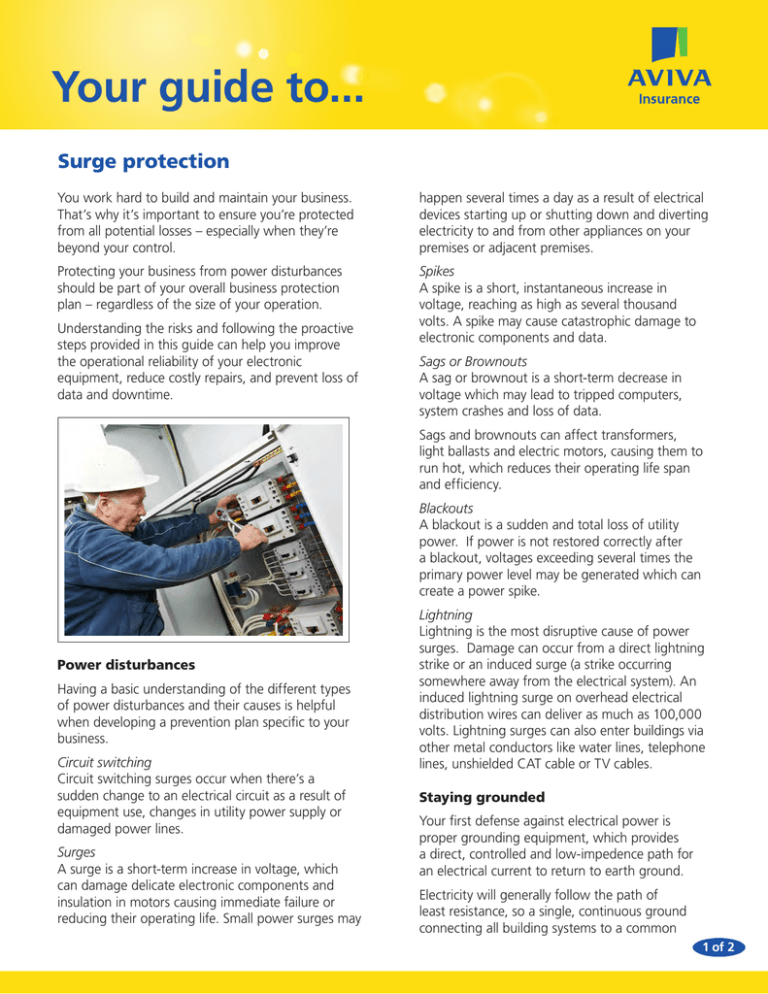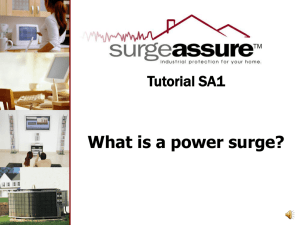
Your guide to...
Surge protection
You work hard to build and maintain your business.
That’s why it’s important to ensure you’re protected
from all potential losses – especially when they’re
beyond your control.
happen several times a day as a result of electrical
devices starting up or shutting down and diverting
electricity to and from other appliances on your
premises or adjacent premises.
Protecting your business from power disturbances
should be part of your overall business protection
plan – regardless of the size of your operation.
Spikes
A spike is a short, instantaneous increase in
voltage, reaching as high as several thousand
volts. A spike may cause catastrophic damage to
electronic components and data.
Understanding the risks and following the proactive
steps provided in this guide can help you improve
the operational reliability of your electronic
equipment, reduce costly repairs, and prevent loss of
data and downtime.
Sags or Brownouts
A sag or brownout is a short-term decrease in
voltage which may lead to tripped computers,
system crashes and loss of data.
Sags and brownouts can affect transformers,
light ballasts and electric motors, causing them to
run hot, which reduces their operating life span
and efficiency.
Blackouts
A blackout is a sudden and total loss of utility
power. If power is not restored correctly after
a blackout, voltages exceeding several times the
primary power level may be generated which can
create a power spike.
Power disturbances
Having a basic understanding of the different types
of power disturbances and their causes is helpful
when developing a prevention plan specific to your
business.
Circuit switching
Circuit switching surges occur when there’s a
sudden change to an electrical circuit as a result of
equipment use, changes in utility power supply or
damaged power lines.
Surges
A surge is a short-term increase in voltage, which
can damage delicate electronic components and
insulation in motors causing immediate failure or
reducing their operating life. Small power surges may
Lightning
Lightning is the most disruptive cause of power
surges. Damage can occur from a direct lightning
strike or an induced surge (a strike occurring
somewhere away from the electrical system). An
induced lightning surge on overhead electrical
distribution wires can deliver as much as 100,000
volts. Lightning surges can also enter buildings via
other metal conductors like water lines, telephone
lines, unshielded CAT cable or TV cables.
Staying grounded
Your first defense against electrical power is
proper grounding equipment, which provides
a direct, controlled and low-impedence path for
an electrical current to return to earth ground.
Electricity will generally follow the path of
least resistance, so a single, continuous ground
connecting all building systems to a common
1 of 2
point is the best way to protect your business against
electrical disturbances.
Specialized protection devices are available through
telecommunication equipment suppliers.
Grounding methods are best developed in
consultation with a qualified contractor, consulting
engineering firm and your local utility as it’s a
complex process.
Note that fuses, circuit breakers or protective relays
are generally much too slow to provide sufficient
protection.
Your surge protection checklist
Surge protection devices
There are many types of surge protection devices
available varying in both price and effectiveness.
3Inspect your entire system network regularly to
ensure electrical systems are maintained and in
good working order.
Before you install your device, ensure it’s compatible
with the equipment you need to protect.
3Consult experts to determine the best level of
protection for your business.
An effective way to protect against voltage
increases is by connecting a Transient Voltage Surge
Suppressor (TVSS) to your critical equipment.
3Conduct a risk assessment of all critical
equipment.
The suppressor is activated when a preset voltage
is reached, absorbing part of the surge energy
and diverting it to ground. It acts like a sponge,
soaking up the energy of the surge and dissipating it
harmlessly. The suppressor is then automatically reset
and ready to handle the next surge.
3Ensure all equipment is properly grounded.
3Install surge protection for building systems
and individual equipment.
3Ensure your surge protector meets the UL/ULC
standard 1449. Look for a label indicating it is UL
listed as a Transient Surge Voltage Suppressor.
The label will also show the “Voltage Protection
Rating” of the unit.
It’s also important to protect electric motors. Install
the surge protection as close as possible to the
motor terminals – or within the starters or supply
switchgear if they are within 100 feet of the motor.
3Revisit your protection plan regularly, and
whenever you add, upgrade or move equipment.
Building surge protection
3Replace existing protective devices with newer
ones as protection technology and codes change.
Type 1 Surge protection devices (SPD) are designed
for installation between the meter and the
distribution panel.
Type 2 SPDs are designed for installation after the
main disconnect.
These devices often fit into a circuit breaker space
in the panel. If you have sub panels throughout the
building, each could be fitted with one.
Electronic equipment can be protected by standalone
units connected to the building power, often in the
form of a power bar/with battery backup.
Telephone lines, computer cabling, and coaxial
cables (Cable TV, exterior TV antenna, radio
communications antennas) also need proper
grounding, and surge/ lightning protection.
For further information on this topic, please contact your
independent insurance broker.
Visit www.avivacanada.com/riskmanagement for
more Your guide to... information sheets on other loss
control topics.
Readers should seek specific advice when dealing with
particular situations. Aviva Canada Inc. accepts no
responsibility for action taken as a result of information
contained in this publication. The information in
Your guide to... is correct at the date of going to press.
Printed and published by Aviva Canada Inc., Website:
www.avivacanada.com
© Copyright, all rights reserved. Aviva and the Aviva
logo are trademarks of Aviva plc and used under license
by Aviva Canada Inc. and its subsidiary companies.
2 of 2




